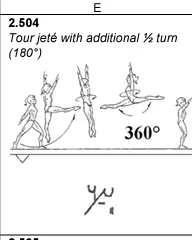New judging mystery/ (mistake?) that would be fun for one our expert judges to attempt to solve.
Sabrina Voinea's beam in team final had a full point off in Difficulty value versus her other attempts at Euros this year. 5.5 vs. the 6.5 she received prior and subsequently.
An entire analysis video claims that the discrepancy is due to her tour jete 1/2 (i.e. full twisting switch/split) being downgraded, which then nullifies her later switch leap + switch 1/2 combo, knocking out the switch 1/2
and knocking out her CR for a leap series.
Initially this sounds logical, but other astute commentators rightly point out that the switch 1/2 is
not the same skill as the tour jete and so that kind of nullification would have been incorrect. The distinction is most obvious on floor exercise, where plenty of gymnasts do
both a tour jete 1/2 (C value) and a split leap 1/1 (D value) in their routines.
Which leads folks to speculate that perhaps her switch 1/2 was itself downgraded, therefore nullifying the switch leap that came directly before it. I find this improbable because... well, her switch 1/2 is rotated completely fine, regardless of other deductions.
Additional plot twist -- apparently the downgraded tour jete 1/2, which she does indeed
never fully rotated should not have been anything special in team finals, and other commentators suggested that the 6.5 d-score she received in other rounds is
already accounting for a total attempted d-score of 6.6
To make this even more confusing: the code seems to describe for the dancer-style tour jete in which your split position is 'cross' instead of parallel to the beam, and the illustration definitely shows someone landing on one foot.... But when it comes to the tour jete 1/2, those aspects of the technique is disregarded, see below. That said, it is at least consistent with this shift on the corresponding skills on floor. :/
G, E, D, D, D, D, C, D
Ro + layout full B+G +0.2 cv
BHs + layout** B+E +0.1cv
Front aerial + split D+B +0.1cv
Side aerial D
Tour jete: D
Switch leap +switch 1/2 + bhs C+D+B +0.2cv + 0.1sb
Ro + bhs + double tuck: B+B+D +0.1sb +0.2 dmtb
2.0 + 1.0 + 3.5
^=6.5 which she's received throughout the meet.
Who can settle this for us?

